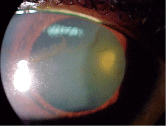 History
History
A 57-year-old black female presented with a painful left eye, which persisted for three days. Her best-corrected visual acuity was 20/20 O.D. and 20/80 O.S.
We ruled out herpes simplex keratouveitis O.S. after noting the presentation of an arborizing keratopathy with terminal end bulbs (dendritic pattern). This was accompanied by dense cell and flare in the anterior chamber.
We medicated the patient with Viroptic (trifluridine, Monarch Pharmaceuticals) q2h, topical prednisolone acetate 1% q.i.d. and topical atropine 1% b.i.d., O.S. We also prescribed Valtrex (valacyclovir, GlaxoSmithKline) 500mg t.i.d. p.o., and asked her to return for follow-up in three days.
This 57-year-old patients visual acuity was worse at follow-up than at her initial visit.
Diagnostic Data

When the patient returned, she was feeling much better, and her left eye demonstrated improvement.
We told her to continue this regimen and return in one week. At the one-week visit, however, her left eye appeared just as bad, if not worse, than the presentation at the initial visit. Her visual acuity was reduced to 20/100 O.S.
Given the worsening visual acuity, severity of the uveitis, and the conundrum of a concurrent HSV corneal infection, we referred the patient to a corneal/anterior segment specialist. The specialist eliminated the topical antiviral preparation and increased the topical steroid to q2h. The specialist scheduled the patient for follow-up visits at our office in one week and at his office in two weeks. The photograph demonstrates the new findings O.S., at the one-week follow-up at our office.
Your Diagnosis
How would you approach this case? Does this case require any other tests?
What is your diagnosis? How would you manage this patient? Whats the likely prognosis?
Thanks to Victoria Dzurinko, O.D., of
The Diagnosis
The diagnosis is hurricane keratopathy, a whorling pigmented keratopathy that occurs secondary to replicating corneal epithelial healing combined with topical steroid use.1,2 When the pigmented phenomenon has no specific pattern, it is referred to as blizzard keratopathy.1,2
Replicative turnover of the corneal epithelium occurs as a population of stem cells at the corneoscleral limbus moves sheets of epithelial cells centripetally from the limbus and circumferentially along the limbus to cover the epithelial defect. During the healing of grafted and non-grafted corneas, either a whorled or vortex pattern may occur on the corneal surface as an effect of gas-permeable contact lens wear and/or topical steroid use.1,2
The vortex typically presents in a clockwise pattern, and is associated with aggressive epithelial cell turnover. Research suggests that this specific pattern is due to the effect of the electromagnetic fields of the eye on the migrating epithelial cells.1,2 The condition usually resolves spontaneously.
Following the specialists treatment, our patients best-corrected visual acuity improved to 20/50 O.S., and the iritis was significantly reduced. While HSV could destroy her cornea, the specialist decided to alter the treatment regimen because intractable uveitis could compromise the entire eye.
At the follow-up with the specialist two weeks later, she recovered completely and demonstrated a best-corrected visual acuity of 20/25 O.S.
1. Dua HS, Gomes JA. Clinical course of hurricane keratopathy. Br J Ophthalmol 2000 Mar;84(3):285-8.
2. Dua HS, Watson NJ, Mathur RM, Forrester JV. Corneal epithelial cell migration in humans: hurricane and blizzard keratopathy. Eye 1993;7(Pt 1):53-8.

